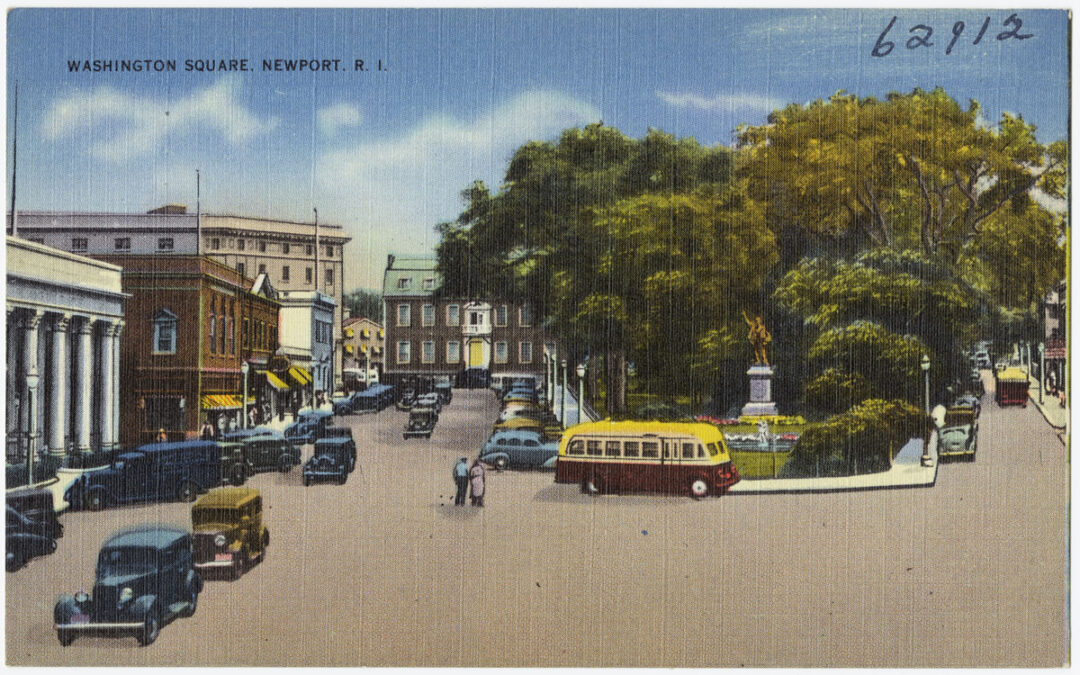When most people think about the subject of “Public Spaces,” streets and sidewalks are not the first thought – they will often immediately think of parks and public squares. The recent debate about and subsequent renovation of Queen Anne Square shows how much attention and passion is wrapped up in these places. Parks like Touro Park, Queen Anne Square, and Washington Square serve as visual punctuation to the buildings which form the street wall and main body of the city. But again, what about the streets and sidewalks?
The streetscape realm that lies between private parcels of land probably represents more than 95% of all the publicly owned space in any city, far overshadowing the parks and squares which so dominate the public imagination. These streets are not just the routes by which vehicles make their way around the city. They are the connective tissues that hold the city together visually. Similarly, sidewalks are not just the space between the road and the building lots, they are the frame that sets up the beauty and historic character of the structures that they border – like picture frames around a painting. This realization that the majority of Public Space has been treated in a purely pragmatic way means that there is a wonderful opportunity to enhance the beauty of our city and accentuate its historic character in ways that have barely been considered. Just caring and thinking more about these realms will help the city planners to do a better job in managing these forgotten resources.
By creating streets and sidewalks that are more conducive to bicycling and walking, city planners have an opportunity to counteract two of the greatest health scourges that the United States is facing today: the tremendous increase in childhood obesity and early onset of Type II diabetes. Mark Fenton; host of Public Television’s show “America’s Walking,” has recently documented how designing better streets and sidewalks can be essential to helping raise “Free Range Children” – kids who are healthy, independent, and more self-sufficient. This also helps free parents from the burden of being glorified chauffeurs, shuttling children from one programmed activity to another endlessly until the children become part of the traffic problem themselves upon gaining their driver’s licenses.
Washington Square is one area where this larger idea of using the streets and sidewalks to full effect is being seen. These renovations include the installation of bluestone sidewalks, raised at side street to be easier to navigate with strollers and wheelchairs and cobble-lined crosswalks meant to slow traffic and make it easier, safer, and more pleasurable for pedestrians to navigate the traffic. Before it was renamed Washington Square in honor of our first commander in chief, this area was known as “The Parade” in that it was the place that militia drilled and the community came together to celebrate common occasions.
Now that it has largely been restored to its historic character and beauty the Square is once again becoming the gathering place for shared events and celebrations. Earlier this year the Square was used to celebrate the colonial traditions of early Newport in honor of John Clarke’s charter of 1663, which established Rhode Island’s religious freedom for the first time. On July Fourth, the Square will be used to celebrate the reading of the Declaration of Independence by the Sons of Liberty as the group has done each year since the first reading of the Declaration from the Colony House 237 years ago! At that first reading it is reported that the Parade was completely packed with as many as 5,000 people to first hear that the signers swear to “pledge to each other our Lives, our Fortunes and our sacred Honor” to achieve liberty and seek independence from an unjust subjugation by the English throne. Join in a re-enactment of this reading at 11:00 a.m. and stay to hear the Newport Artillery Company fire their canons in salute!
This gathering will not only be the celebration of the patriotic traditions of this country but also its historic traditions of city design where sidewalks, street, and public roadways were not just the means to get somewhere else but actually a place to walk, shop, and gather as a community and to help citizens live ricer, fuller and healthier lives. Now that is something worth celebrating!
Looking to remodel your home? Let’s connect.
Join the Architectural Forum to stay up-to-date with architectural news from Rhode Island and abroad.
Ross Sinclair Cann, AIA, LEED AP, is a historian, urban planner, educator, and practicing architect living and working in Newport. This article was initially published in ARCHI-TEXT, in Newport This Week, July 3, 2013.
